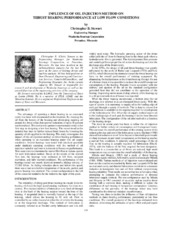| dc.contributor.other | Turbomachinery Symposium (28th : 1999) | |
| dc.creator | Stewart, Christopher B. | |
| dc.date.accessioned | 2017-10-05T14:03:25Z | |
| dc.date.available | 2017-10-05T14:03:25Z | |
| dc.date.issued | 1999 | |
| dc.identifier.uri | https://hdl.handle.net/1969.1/163392 | |
| dc.description | Lecture | en |
| dc.description | Pg. 133-140 | en |
| dc.description.abstract | The advantage of operating a thrust bearing in an evacuated cavity has been well documented in the literature. By draining the
oil from the bottom of the housing and eliminating standing oil around the thrust collar, horsepower reductions of up to 50 percent can be realized. The decision to operate in an evacuated cavity is the first step in designing a low loss bearing. The recent trend in the industry has been to further reduce thrust losses by lowering the quantity of oil supplied to the bearing. This study investigates the impact of the oil injection method on thrust bearing performance when operating in an evacuated housing under low oil supply conditions. Several bearings were tested with identical geometry under duplicate operating conditions with the method of oil
injection varied in each test to isolate its influence on performance. Tests were done to determine the starved film flow at various speeds for each lubrication method. Based on the results of the starved flow test, the bearings were evaluated at full flow, incipient
starvation, and fully starved conditions. The performance of the bearings tested was nearly identical around a sliding velocity of 12,300 ft/min. At sliding velocities above and below this speed, there was a load at which the temperature of the nozzle, pocket, and
groove bearing was identical. The coolest configuration to the left of the crossover tended to be the hottest to the right of this point. | en |
| dc.format.medium | Electronic | en |
| dc.format.mimetype | application/pdf | |
| dc.language.iso | en | |
| dc.publisher | Texas A&M University. Turbomachinery Laboratories | |
| dc.relation.ispartof | Proceedings of the 28th Turbomachinery Symposium | en |
| dc.subject.lcsh | Turbomachines | en |
| dc.title | Influence Of Oil Injection Method On Thrust Bearing Performance At Low Flow Conditions. | en |
| dc.type.genre | Presentation | en |
| dc.type.material | Text | en |
| dc.identifier.doi | https://doi.org/10.21423/R19D3B | |


